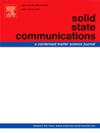Ir2NiSn和Ru2NiSn Heusler合金密度泛函理论研究
IF 2.1
4区 物理与天体物理
Q3 PHYSICS, CONDENSED MATTER
引用次数: 0
摘要
利用密度泛函理论方法对 Ir2NiSn 和 Ru2NiSn 合金进行了评估,结果表明 FM-L21 型结构是 Ir2NiSn 和 Ru2NiSn 合金稳定的放热基态构型。形成能计算证实了所研究化合物合金的稳定性,计算结果一致表明形成能为负值。Ir2NiSn 和 Ru2NiSn Heusler 合金的形成能分别为 -3.66 eV 和 -5.95 eV。弹性特性表明合金具有稳定的弹性、韧性和各向异性。计算得出的电子状态密度表明,合金在自旋下降和自旋上升构型中都具有金属特性。合金的自旋构型归因于 Ni 原子和 Ir/Ru 原子的 3d 轨道。Ni 原子和 Ir/Ru 原子的过渡金属原子之间产生了明显的 d-d 轨道杂化,导致价带和导带附近的自旋崛起级状态减少。在 GGA-PBE (mBJ-GGA-PBE) 方法中,Ir2NiSn 和 Ru2NiSn 合金每个单位晶胞的总自旋磁矩分别为 1.13 (1.43) 和 1.84 (2.22) μB。计算了两种合金的机械性能,包括体积模量、剪切模量和杨氏模量,并观察到两种合金的稳定性。所评估的 Ir2NiSn 和 Ru2NiSn 合金具有作为自旋电子材料的潜在应用价值。本文章由计算机程序翻译,如有差异,请以英文原文为准。
Density functional theory studies of Ir2NiSn and Ru2NiSn Heusler alloys
Ir2NiSn and Ru2NiSn alloys were evaluated using density functional theory approach and the FM-L21-type structure was obtained as the stable exothermic ground state configuration for the Ir2NiSn and Ru2NiSn alloys. The stability of the compounds alloys under investigation is substantiated by formation energy calculations, which consistently indicate negative formation energies. The formations energies of Ir2NiSn and Ru2NiSn Heusler alloys are −3.66 eV and −5.95 eV respectively. The elastic properties demonstrate that the alloys are stable elastically, ductile and anisotropic. The calculated electronic density of state shows that the alloys have metallic character in both the spin-down and spin-up configurations. The spin configuration for the alloys is attributed to the 3d orbitals of Ni and Ir/Ru atoms. The significant d-d orbital hybridization obtained between the transition metal atoms of the Ni and Ir/Ru atoms resulted in the reduction of states at the spin-up level around the valence and conduction bands. Within the GGA-PBE (mBJ-GGA-PBE) approach, the total spin magnetic moments per unit cell of Ir2NiSn and Ru2NiSn alloys are 1.13 (1.43) and 1.84 (2.22) μB. The mechanical properties, including the bulk modulus, shear modulus, and Young's modulus, were calculated for both alloys, and stability was observed across both alloys. The evaluated Ir2NiSn and Ru2NiSn alloys have potential application as spintronic materials.
求助全文
通过发布文献求助,成功后即可免费获取论文全文。
去求助
来源期刊

Solid State Communications
物理-物理:凝聚态物理
CiteScore
3.40
自引率
4.80%
发文量
287
审稿时长
51 days
期刊介绍:
Solid State Communications is an international medium for the publication of short communications and original research articles on significant developments in condensed matter science, giving scientists immediate access to important, recently completed work. The journal publishes original experimental and theoretical research on the physical and chemical properties of solids and other condensed systems and also on their preparation. The submission of manuscripts reporting research on the basic physics of materials science and devices, as well as of state-of-the-art microstructures and nanostructures, is encouraged.
A coherent quantitative treatment emphasizing new physics is expected rather than a simple accumulation of experimental data. Consistent with these aims, the short communications should be kept concise and short, usually not longer than six printed pages. The number of figures and tables should also be kept to a minimum. Solid State Communications now also welcomes original research articles without length restrictions.
The Fast-Track section of Solid State Communications is the venue for very rapid publication of short communications on significant developments in condensed matter science. The goal is to offer the broad condensed matter community quick and immediate access to publish recently completed papers in research areas that are rapidly evolving and in which there are developments with great potential impact.
 求助内容:
求助内容: 应助结果提醒方式:
应助结果提醒方式:


